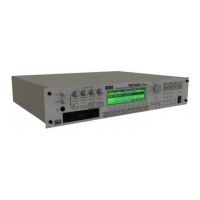65
Basic functions
Sampling mode
Sampling mode
The TRITON-Rack provides high-performance mono/
stereo sampling.
None of the multisample or sample data in Sam-
pling mode is backed up when the power is turned
off. If you wish to keep this data, you must save it
onto a floppy disk or external SCSI device (if the
separately sold EXB-SCSI option is installed)
before turning off the power.
Immediately after the power is turned on, memory
will not contain multisample or sample data. You
must first load previously-saved data before you
can play back or edit it.
Features of sampling mode
• 48 kHz 16 bit linear mono/stereo sampling.
• 16 Mbytes of sample (waveform) data memory is
standard, allowing you to sample for
approximately 2 minutes 54 seconds in monaural,
or approximately 1 minute 27 seconds in stereo. By
installing 72 pin SIMM modules, you can expand
the memory to a maximum of 96 Mbytes, which
will allow you to record up to six 2 minute 54
second samples in mono (or four 1 minute 27
second samples in stereo), for a maximum total of
approximately 17 minutes 28 seconds of sampling
time. (For details on expansion, refer to PG p.243.)
•A maximum of 1,000 multisamples and 4,000
samples can be created.
• In Disk mode you can load multisample/sample
data from a floppy disk or SCSI media (when the
separately sold EXB-SCSI option is installed).
• Korg format or Akai (S1000/3000) format sample
data, and AIFF or WAVE format sample data can
be loaded. (Once data has been loaded into the
TRITON-Rack, it will all be treated as Korg format
sample data.)
Sample data created on the TRITON-Rack can be
exported (output) as an AIFF or WAVE format sam-
ple file.
• The external audio source that you are sampling
can be processed by the five insertion effects to
apply effects such as compressor, EQ, or lo-fi. The
LFO frequency or delay time of the effect can be
specified as a BPM value, which is highly effective
when sampling phrase loops etc.
• Both auto sampling and manual sampling can be
performed. With auto sampling, recording will
begin automatically when the input level exceeds a
specified threshold. In either method of sampling,
you can make pre-trigger settings.
• The audio input supports both mic and line level
signals.
• Data you sampled can be played immediately from
the keyboard of a connected MIDI instrument or by
pressing the [AUDITION] key. It is also easy to
convert sampled data into a program, and use it as
material for the TRITON-Rack’s HI synthesis
system. Multisamples/samples that have been
converted into a program can be used in a
combination or multi.
• The waveform can be viewed in the LCD screen,
and edited by a variety of waveform editing
commands that include rate convert (down-
sampling) and reverse playback.
The following commands are also provided.
Time Slice
This automatically detects the attack portions of a
kick or snare etc. in a rhythm loop sample (a looped
pattern of drums etc.), and divides it into separate
rhythm instrument sounds. A pattern correspond-
ing to the divided samples is created automatically,
so that you can immediately use the Multi mode
RPPR function to play the pattern and adjust the
tempo without changing the pitch. You can also do
things such as adjusting the pitch of only the snare,
replacing it with a different sample, or changing the
playback timing on the sequencer, in this way creat-
ing a new rhythm loop based on the rhythm loop
you started with. (Stereo samples are supported.)
Time Stretch
This lets you modify the tempo without changing
the pitch of a sample. You can select either Sustain-
ing (suitable for sustain-type instruments such as
strings or vocals), or Slice (suitable for rhythm loops
on decay-type instruments such drums). Stereo sam-
ples are supported.
Crossfade Loop
An important looping tool that helps smooth out
irregularities in long loops which contain complex
material. By executing Crossfade Loop, you can
eliminate this problem and create natural-sounding
loops.
Link (with Crossfade)
This allows you to join two samples into a single
sample. You can also crossfade the overlapping por-
tion of the samples at this time, so that the volume
changes gradually, producing a natural-sounding
transition.
• The BPM Adjust function (playback pitch adjust)
lets you adjust the playback pitch of each index so
that the loop frequency matches the desired BPM
value.
• Start, loop start, and end addresses can be specified
in units of a single sample. Loop tune, reverse
playback, and loop lock functions are also
supported.
• The Use Zero function automatically searches for
zero-cross points, making it easy to find the
beginning or end of the waveform, or locations that
will not produce noise when the sample is played
back.

